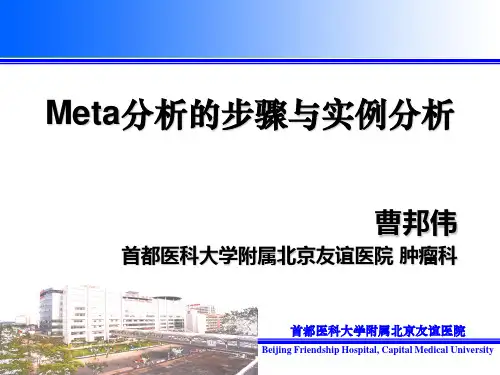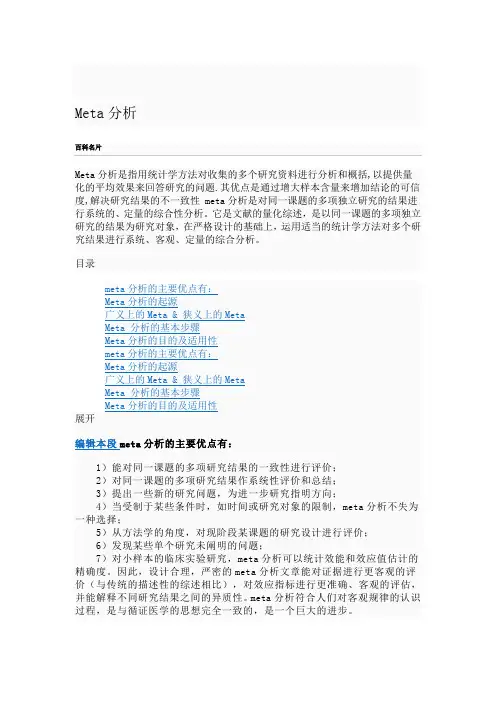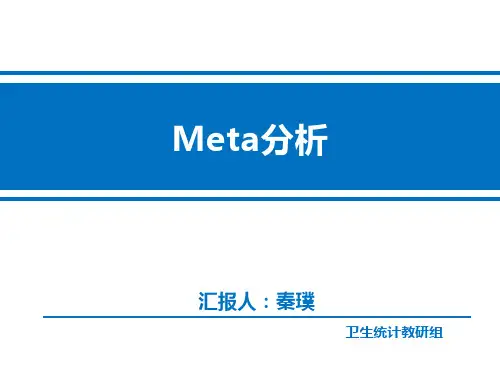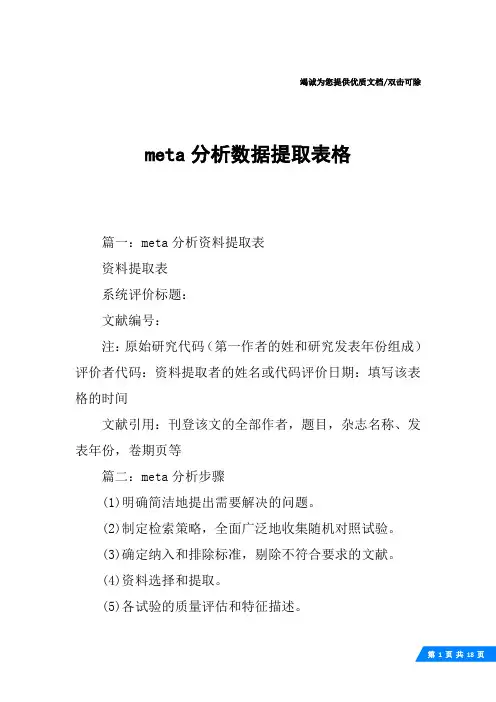Meta分析数据提取与分析
- 格式:pptx
- 大小:5.41 MB
- 文档页数:45





Meta分析Meta分析是指用统计学方法对收集的多个研究资料进行分析和概括,以提供量化的平均效果来回答研究的问题.其优点是通过增大样本含量来增加结论的可信度,解决研究结果的不一致性 meta分析是对同一课题的多项独立研究的结果进行系统的、定量的综合性分析。
它是文献的量化综述,是以同一课题的多项独立研究的结果为研究对象,在严格设计的基础上,运用适当的统计学方法对多个研究结果进行系统、客观、定量的综合分析。
目录meta分析的主要优点有:Meta分析的起源广义上的Meta & 狭义上的MetaMeta 分析的基本步骤Meta分析的目的及适用性meta分析的主要优点有:Meta分析的起源广义上的Meta & 狭义上的MetaMeta 分析的基本步骤Meta分析的目的及适用性展开编辑本段meta分析的主要优点有:1)能对同一课题的多项研究结果的一致性进行评价;2)对同一课题的多项研究结果作系统性评价和总结;3)提出一些新的研究问题,为进一步研究指明方向;4)当受制于某些条件时,如时间或研究对象的限制,meta分析不失为一种选择;5)从方法学的角度,对现阶段某课题的研究设计进行评价;6)发现某些单个研究未阐明的问题;7)对小样本的临床实验研究,meta分析可以统计效能和效应值估计的精确度。
因此,设计合理,严密的meta分析文章能对证据进行更客观的评价(与传统的描述性的综述相比),对效应指标进行更准确、客观的评估,并能解释不同研究结果之间的异质性。
meta分析符合人们对客观规律的认识过程,是与循证医学的思想完全一致的,是一个巨大的进步。
编辑本段Meta分析的起源Meta分析的前身源于Fisher 1920年“合并P值”的思想;1955年由Beecher首次提出初步的概念;1976年心理学家Glass进一步按照其思想发展为“合并统计量”,称之为Meta分析;1979年英国临床流行病学家Archie Cochrane提出系统评价(Systematic Review,SR)的概念,并发表了《激素治疗早产孕妇降低新生儿死亡率随机对照试验的系统评价》。

meta分析数据处理流程方法英文回答:Meta-analysis is a statistical technique used to combine and analyze data from multiple studies on a specific research question or topic. It involves a systematic review of the literature, data extraction, and statistical analysis to provide a comprehensive summary of the available evidence.The data processing workflow for conducting a meta-analysis typically includes the following steps:1. Formulating the research question: This step involves clearly defining the research question or objective of the meta-analysis. It is important to specify the inclusion and exclusion criteria for selecting studies to ensure the relevance and quality of the data.2. Literature search: A comprehensive search isconducted to identify relevant studies. This involves searching electronic databases, such as PubMed or Web of Science, as well as manual searching of reference lists and contacting experts in the field. The search strategy should be transparent and replicable.3. Study selection: In this step, the identified studies are screened based on predefined inclusion and exclusion criteria. Each study is evaluated independently by two or more reviewers to ensure consistency and minimize bias. Any discrepancies are resolved through discussion or by involving a third reviewer.4. Data extraction: Data extraction involves systematically extracting relevant information from each included study. This typically includes study characteristics (e.g., study design, sample size), participant characteristics, intervention/exposure details, outcome measures, and effect sizes or relevant statistics. It is important to ensure accurate data extraction to minimize errors.5. Statistical analysis: The extracted data are then analyzed using appropriate statistical methods. This may involve calculating summary statistics, such as effect sizes or odds ratios, and conducting meta-regression or subgroup analyses to explore sources of heterogeneity. The choice of statistical methods depends on the nature of the data and research question.6. Assessment of heterogeneity: Heterogeneity refers to the variability in effect sizes across studies. It is important to assess heterogeneity using statistical tests, such as the Q-statistic or I^2 statistic. If significant heterogeneity is present, further exploration through sensitivity analysis or subgroup analysis may be necessary.7. Publication bias assessment: Publication bias refers to the selective publication of studies based on their findings. It is important to assess publication bias using statistical tests, such as funnel plots or Egger's regression test. If publication bias is detected, appropriate adjustments, such as trim-and-fill analysis, may be applied to account for it.8. Interpretation of results: The final step involves interpreting the results of the meta-analysis and drawing conclusions based on the available evidence. This includes discussing the strengths and limitations of the included studies, the overall effect size, and any implications for practice or future research.中文回答:meta分析是一种统计技术,用于结合和分析关于特定研究问题或主题的多个研究数据。




竭诚为您提供优质文档/双击可除meta分析数据提取表格篇一:meta分析资料提取表资料提取表系统评价标题:文献编号:注:原始研究代码(第一作者的姓和研究发表年份组成)评价者代码:资料提取者的姓名或代码评价日期:填写该表格的时间文献引用:刊登该文的全部作者,题目,杂志名称、发表年份,卷期页等篇二:meta分析步骤(1)明确简洁地提出需要解决的问题。
(2)制定检索策略,全面广泛地收集随机对照试验。
(3)确定纳入和排除标准,剔除不符合要求的文献。
(4)资料选择和提取。
(5)各试验的质量评估和特征描述。
(6)统计学处理。
a.异质性检验(齐性检验)。
b.统计合并效应量(加权合并,计算效应尺度及95%的置信区间)并进行统计推断。
c.图示单个试验的结果和合并后的结果。
d.敏感性分析。
e.通过“失安全数”的计算或采用“倒漏斗图”了解潜在的发表偏倚。
(7)结果解释、作出结论及评价。
(8)维护和更新资料。
提高国内随机对照试验meta-分析的质量何成奇,赵晓玲(四川大学华西医院康复中心,四川省成都市610041)[摘要]高质量的随机对照试验(Rct)的meta-分析结果与国际公认的大样本Rct结果一起被各国列为最高等级的证据,可为临床实践和卫生决策提供更真实的科学依据,引导临床医师在实践中做出正确的决策。
但质量差的meta-分析反而可能导致错误的结论。
国外meta-分析方法的应用已趋于成熟和规范。
然而目前国内由于应用时间不长,且缺乏统一规范的实施标准,文献质量参差不齐,很多方面还存在着较为严重的缺陷。
探讨如何提高国内Rctmeta-分析的质量,尽快与国际接轨,以便为循证医学、药学提供更科学真实的证据。
以进行Rctmeta-分析的步骤为线索,对国内meta-分析存在的问题和解决的办法进行了综述。
具体内容包括:提出一个好问题(研究目的),全面收集相关的Rct,制定严格的纳入/排除标准,正确提取数据资料,对符合纳入标准的Rct进行质量评价,应用正确的统计方法,必须进行敏感性分析,根据结果做出正确、全面的结论。

系统评价Meta分析详细介绍目录一、系统评价Meta分析的基本概念 (2)1.1 系统评价的定义 (3)1.2 Meta分析的定义 (4)二、系统评价Meta分析的目的和意义 (4)三、系统评价Meta分析的流程 (5)3.1 明确研究问题 (6)3.2 检索文献 (7)3.3 筛选文献 (8)3.4 数据提取 (9)3.5 整理数据 (10)3.6 进行Meta分析 (11)3.7 结果解释 (12)3.8 评估偏倚风险 (13)3.9 结果的综合评价 (14)四、系统评价Meta分析中的统计方法 (15)4.1 基本统计方法 (16)4.2 元分析统计方法 (17)五、系统评价Meta分析的质量评价 (19)5.1 文献质量评价 (20)5.2 结果的一致性评价 (21)5.3 可靠性评价 (22)六、系统评价Meta分析的结果解释和应用 (24)6.1 结果的解释 (25)6.2 结果的应用 (26)6.3 对未来研究的启示 (27)七、系统评价Meta分析的局限性 (28)7.1 样本选择偏差 (29)7.2 数据质量问题 (31)7.3 不同研究结果间的异质性 (32)八、系统评价Meta分析的伦理问题 (33)8.1 保护受试者隐私 (35)8.2 避免学术不端行为 (36)九、系统评价Meta分析的未来发展趋势 (37)9.1 技术的发展 (38)9.2 方法学的创新 (39)一、系统评价Meta分析的基本概念系统评价(Systematic Review,简称SR)是一种多学科研究方法,旨在通过收集、整理和分析大量关于某一主题的独立研究结果,以便得出全面、准确和可靠的结论。
Meta分析(Metaanalysis)是系统评价的一种扩展和深化,它通过对多个独立研究的统计分析,对原始研究结果进行加权汇总,以提高研究结果的可靠性和推广性。
系统评价的目的是对现有的研究进行全面、客观和公正的评估,从而为实践提供有价值的指导。
Meta分析的步骤Meta分析是一种通过合并多个独立研究的结果来获得更准确、可靠的结论的统计分析方法。
它可以帮助研究者总结和评估大量相关研究的结果,从而提供更全面的证据支持决策和政策制定。
下面将介绍Meta分析的完整步骤。
第一步:明确研究问题在进行Meta分析之前,需要明确研究的目的和问题。
这将有助于确定所需的研究类型和选择适当的研究策略。
第二步:收集相关研究第三步:筛选研究第四步:提取数据在提取数据时,研究者应根据预先设计的数据提取表,从每个纳入研究中提取所需的数据。
这些数据可以包括研究特征、样本大小、效应量(如均值、标准差、相对风险等)和其他相关变量。
第五步:评估研究质量评估研究质量是Meta分析的关键步骤之一、研究者可以使用一些评估工具,如Cochrane协作网络(Cochrane Collaboration)提供的工具来评估纳入研究的质量。
这些工具通常包括随机对照试验的风险偏倚评估工具和观察研究的质量评估工具。
第六步:进行统计分析在进行统计分析之前,研究者需要对纳入研究的数据进行预处理。
这可能包括转换效应量、计算合适的权重和调整相关的不一致性。
然后,根据研究设计和变量特征,选择合适的统计模型进行分析。
常用的统计模型包括固定效应模型和随机效应模型。
固定效应模型假设所有研究的效应量相同,而随机效应模型允许研究之间存在异质性。
第七步:进行效应量合并在进行效应量合并之前,需要考虑研究之间的异质性。
如果研究之间的异质性较小,则可以使用固定效应模型进行合并。
如果研究之间的异质性较大,则应使用随机效应模型进行合并。
研究者还可以使用森林图或漏斗图等图形来显示合并效应量和置信区间。
第八步:评估结果的稳健性在评估结果的稳健性时,研究者可以进行敏感性分析和亚组分析。
敏感性分析是通过排除一些研究或改变分析方法来检验结果的稳健性。
亚组分析是将研究按照一些特定特征进行分类,然后比较不同亚组间的效应量。
这可以帮助研究者了解不同因素对结果的影响。